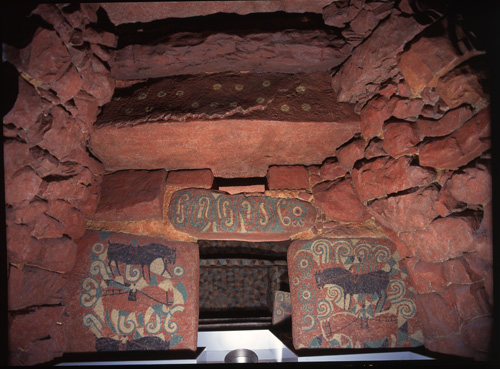
The photograph shown here is of a replica of the mural wall.
Decorated tombs (sōshoku kofun) are those with geometric designs or motifs of equipment, animals, and men applied through engraving, bas-relief carving, or painting to the walls of horizontal stone or other styles of burial chambers, or to the stone coffins placed within. There are at least 600 decorated tombs in Japan, centered in the western part of the country and extending to the southern Tōhoku region, but most are distributed over Kyushu. Also, as changes in the content of decorations are observed over time and between regions, they are extremely valuable for learning about transitions in the notions of life and death and in mortuary rituals of the Kofun period, and about regional differences.
At the same time, these decorations are at risk of deterioration due to humidity within the chambers and other environmental factors, and measures are needed for their conservation. Based on its experience in the conservation of tombs with murals such as the Takamatsuzuka and Kitora mounds, both designated as Special Historic Sites, the Agency for Cultural Affairs is currently engaging more broadly with the protection of decorated tombs. Given the circumstances of decorated tombs being damaged in the Great East Japan Earthquake and the 2016 Kumamoto earthquakes, we introduce in this collection the current conditions of conservation and utilization of decorated tombs, and the restoration efforts being made for tombs that were struck by these disasters. (Morisaki Kazuki)
Special Historic Site Ōzuka Tomb, Fukuoka prefecture (replica of the forechamber)

